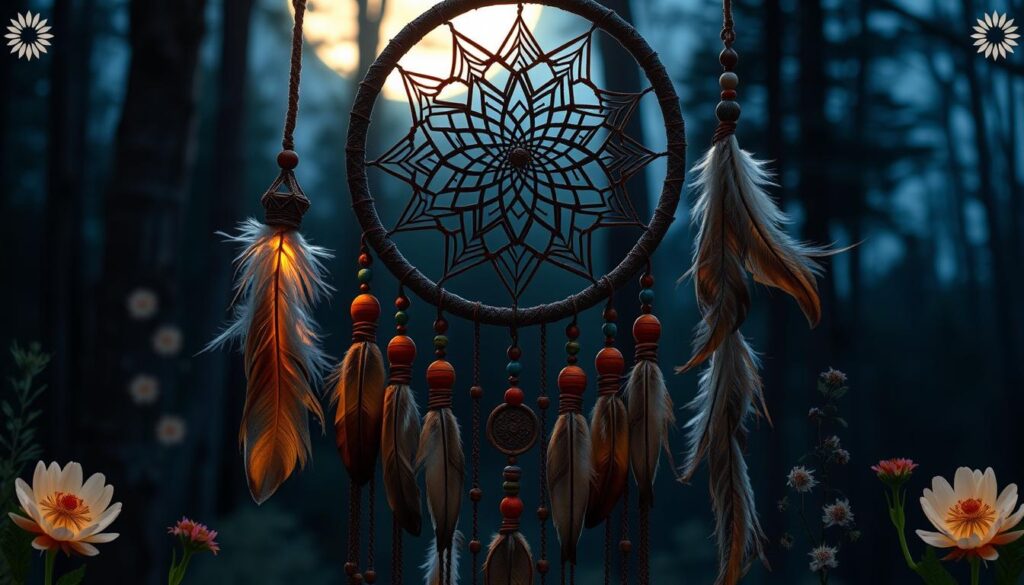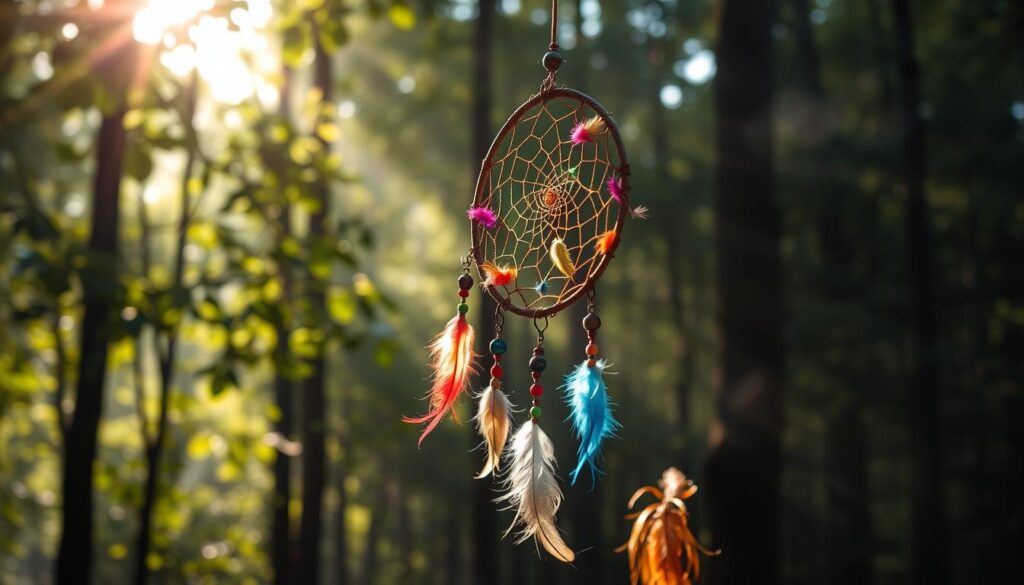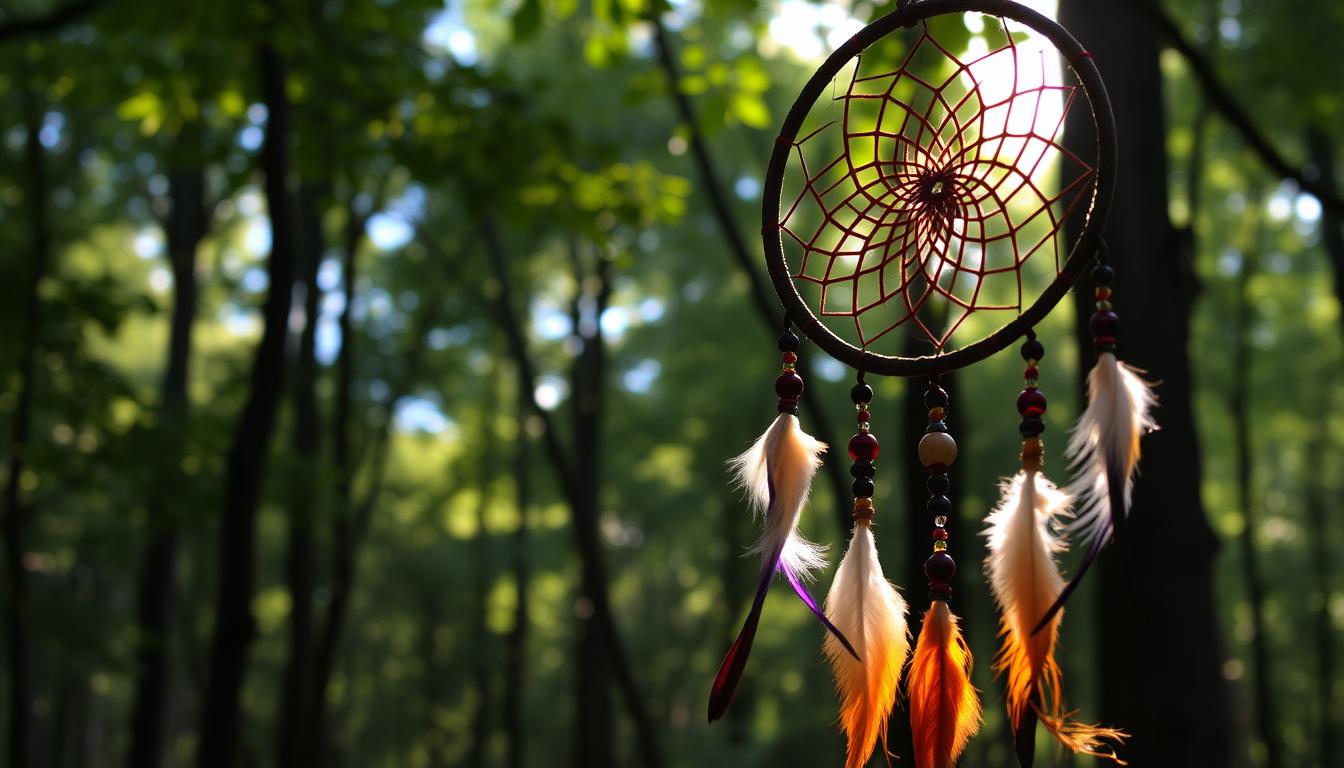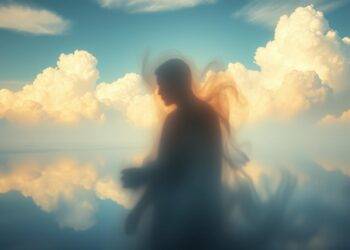“The dreamcatcher’s symbolism spans generations, reminding us of our deep-rooted connection to the natural world and the wisdom of Indigenous cultures.” – Dr. Jane Goodall, Renowned Primatologist and Anthropologist
Dreamcatchers have won the hearts of people everywhere. These beautiful willow hoops, made into nets with feathers and beads, symbolize Native American tradition, cultural symbolism, and spiritual objects. Their journey from ancient tribes to today shows the lasting impact of Indigenous knowledge and Native American strength.
Key Takeaways
- Dreamcatchers started with the Ojibwe (Chippewa) people of North America, used as protective charms.
- In the 1960s and 1970s, dreamcatchers became a symbol of unity and Indigenous identity during the Pan-Indian Movement.
- They are made with willow hoops, natural fibers, and decorated with feathers and beads, each part holds deep meaning.
- Many Native American communities see the misuse of dreamcatchers as offensive, as they hold sacred cultural value.
- The commercialization of dreamcatchers has led to the misuse of Indigenous craftsmanship, highlighting the need to support real Native artisans.
The Origins and Cultural Significance of Dreamcatchers
Dreamcatchers are deeply rooted in Ojibwe legends and indigenous crafts. They hold profound cultural symbolism across Native American communities. The tradition started with the Ojibwe tribe, one of the largest in North America. They were known for hunting, fishing, and gathering wild rice.
Early Ojibwe Traditions
The first mention of dreamcatchers was in Frances Densmore’s 1929 book “Chippewa Customs.” Initially, they were used as protective charms for infants. These hoops were hung on cradle boards to filter dreams, letting only the good ones through.
Spread Across Native American Communities
Over time, dreamcatchers spread to other Native American communities. They became a symbol of indigenous solidarity and cultural identity. Dreamcatchers have been adapted in various ways, showing the unique cultural identities of each tribe while keeping their core symbolism.
Cultural Importance in Indigenous Life
Dreamcatchers hold deep spiritual significance in Native American cultures. They represent a connection to ancestral wisdom, the natural world, and the cyclical nature of existence. The rituals and ceremonies around their creation involve prayers, giving them spiritual power. This shows the deep reverence Native American tribes have for these symbols.
| Statistic | Value |
|---|---|
| Only 40 years since the AIM movement in the 1960s and 1970s, the common misconception remains that dreamcatchers have always been an integral part of most Native American cultures. | 40 years |
| Since the 1970s, many variations of dreamcatchers have appeared due to their commercialization, with end-point weaves becoming uncommon in favor of mid-point weaves, loops, and stars. | Since the 1970s |
| The Indian Arts and Crafts Act of 1990 prohibits manufacturers from suggesting their products are Native-made unless they are a member of a federally or State-recognized Indian Tribe or certified as an Indian artisan. | 1990 |
| Dreamcatchers have become popular across cultural boundaries, indicating widespread acceptance and interest in their symbolism and cultural significance. | Widespread acceptance |

The resilience of indigenous traditions in preserving their cultural identity is remarkable. Dreamcatchers have become a symbol of Native American heritage, even with external influences and commercial popularity. By appreciating and understanding their cultural significance, we can honor their legacy and inspire future generations.
The Legend of Asibikaashi: The Spider Woman’s Gift
In the rich tapestry of Native American tradition, Asibikaashi, the Spider Woman, is highly revered. She watched over all Ojibwe infants and adults across North America. But as the Ojibwe people moved, her task grew too big, and she had to protect more spiritual objects.
The women of the Ojibwe took on a sacred duty. They wove protective webs and charms, known as dreamcatchers, to keep their infants safe. This Ojibwe legend is the heart of the dreamcatcher’s deep spiritual meaning, making it a treasured symbol in their culture.
“The dreamcatcher’s web is said to filter out bad dreams, allowing only good ones to pass through to the sleeper.”
The dreamcatcher’s design, with its willow hoop and fine web, is like Asibikaashi’s work. It catches negative energies and lets good ones through. This belief has made the dreamcatcher a highly valued spiritual object in Native American tradition.

The dreamcatcher started with the Ojibwe but has spread to many Native American communities. It’s now a symbol of protection, harmony, and connection to nature. Its lasting impact inspires and fascinates those who want to honor the Ojibwe legends and traditions that created this remarkable spiritual object.
Understanding Traditional Dreamcatcher Design Elements
The dreamcatcher’s design holds deep cultural meaning passed down through generations. Each part, from the hoop to the feathers and beads, has its own significance. These elements are key to Native American traditions.
The Sacred Geometry of the Hoop
The hoop of the dreamcatcher, circular or teardrop-shaped, symbolizes the circle of life. It shows how all beings are connected. This design reflects the cycle of birth, death, and rebirth in Native American spirituality.
Symbolism of Web Patterns
The web inside the hoop is made of nettle fiber or yarn. It acts as a filter, catching bad dreams and letting good ones through. The web’s design shows the creator’s skill and represents the connection of all living things.
Meaning Behind Feathers and Beads
Feathers on the dreamcatcher symbolize the ladder for good dreams to reach us. Beads represent the spider or the dreams themselves. They show the dreamcatcher’s purpose in a tangible way.
The dreamcatcher’s design, from the hoop to the beads, is a true work of handcrafted art and indigenous crafts. It is filled with cultural symbolism that fascinates and inspires people globally.
Dreamcatchers: Ancient Lore and Modern Practice
Dreamcatchers have changed a lot since their ancient times. They are now symbols in today’s culture. This change shows how traditional Native American spirituality meets modern society. Dreamcatchers are still important to many Indigenous people but have also become popular decorations and spiritual symbols. This has led to talks about cultural appropriation and staying true to their roots.
The Ojibwa Nation is often credited with starting dreamcatchers. This tradition has spread to many Indigenous tribes in North America. These beautiful hoops, with feathers and beads, were thought to catch bad dreams and negative energies. They let good energy pass through. Feathers connected humans to the divine, and beads stood for the spider’s web that caught bad dreams.
“Dream catchers are believed to capture bad dreams and clarify good ones.”
Dreamcatchers also help bring positive energy into homes and workspaces. Their calming effect and deep meaning have made them a favorite in many Native American cultural practices.
In recent years, dreamcatchers have become trendy decorations and fashion items in Western culture. This has raised questions about cultural appropriation and the need to respect their true spiritual and cultural symbolism. As dreamcatchers grow in popularity, it’s important to remember their deep ancient lore and keep their modern use respectful and meaningful.
The Role of Dreams in Native American Spirituality
In the rich tapestry of Native American tradition, dreams are deeply meaningful. They are seen as powerful ways to understand prophecies, personal symbols, and our spiritual bond with the earth. Dreamcatchers, with their intricate webs, symbolize the Native American belief in dreams.
Prophetic and Spiritual Significance
For many Native American tribes, dreams are messages from the spirit world. They offer guidance and wisdom for both individuals and communities. Tribes like the Mohave, Iroquois, and Abenaki use dreams to make important decisions.
Dreams help connect with the Creator, leading to deep spiritual experiences and healing powers.
Dream Interpretation in Tribal Culture
Interpreting dreams was key in Native American spirituality. Shamans and Medicine Men/Women were respected for understanding dream meanings. They used these interpretations to guide individual and communal actions, creating a strong bond between the physical and spiritual worlds.
“Dreams were regarded as a way to connect with the Creator or a higher power, leading to profound spiritual experiences.”
Dreams in Native American tradition are more than symbols; they are paths to the spirit world. They offer insights and guidance that shape tribal life. Dreamcatching and dream interpretation have helped Native American cultures keep a rich spiritual legacy alive.
Crafting Techniques and Sacred Materials
Making a dreamcatcher is a sacred act that connects the maker to the Ojibwe people’s rich culture. The materials used have deep symbolic meanings. Each one is chosen to give the dreamcatcher spiritual importance.
The dreamcatcher starts with a willow hoop, symbolizing life’s endless cycle. A web, made from nettle fibers or yarn, is then woven into it. This web is believed to block bad energies, letting only good dreams through.
Feathers are added to the dreamcatcher, each with its own spiritual meaning. Fluffy white feathers mean purity, while striped brown feathers offer protection and guidance. Beads, in various colors, also carry deep cultural meanings, reflecting different Ojibwe beliefs.
| Traditional Dreamcatcher Materials | Symbolic Significance |
|---|---|
| Willow Hoop | Represents the never-ending cycle of life |
| Nettle Fiber or Yarn Web | Filters out negative energies, allowing only positive dreams to pass through |
| Feathers | Symbolize purity, protection, and spiritual connection |
| Beads | Represent different aspects of Ojibwe beliefs and values |
Creating a dreamcatcher is a sacred act that connects the maker to the Ojibwe people’s traditions. By using these handcrafted art materials and techniques, artisans honor the indigenous crafts and sacred objects of their ancestors.
“The dreamcatcher is a sacred object, woven with intention and imbued with the spirit of the maker. It is a bridge between the physical and spiritual realms, a vessel for the protection and guidance of our ancestors.”
The Lakota Perspective and Alternative Legends
The Ojibwe tradition of dreamcatchers is well-known, but the Lakota people have their own story. In the Lakota legend, Iktomi, a spider-like figure, gives a dreamcatcher to the people. This shows how Lakota beliefs and cultural symbolism differ within the Native American tradition.
Iktomi’s Wisdom
Iktomi, the trickster, makes the dreamcatcher for the tribe, the Lakota legend says. He weaves the web, saying it will catch bad dreams and let good ones through. But the Lakota see it as Iktomi’s gift, not just a dream filter.
Differences in Cultural Interpretations
- The Lakota legend sees Iktomi as a trickster, while the Ojibwe focus on the dreamcatcher’s dream-filtering role.
- The Lakota view the dreamcatcher as a symbol of Iktomi’s kindness, while the Ojibwe see it as a protector.
- These different views show the rich cultural stories and spiritual beliefs in various Native American groups.
The Lakota dreamcatcher legend adds depth to our understanding of cultural symbolism and Native American traditions around this symbol.
Evolution of Dreamcatchers Through Time
Dreamcatchers have changed a lot, moving from their roots in Ojibwe tradition to being a popular handcrafted art in many Native American communities. This change shows how Indigenous practices can adapt and grow. It also shows the blending of ancient lore and modern practice.
The Ojibwe (Chippewa) people first made dreamcatchers from natural things like willow, leather, and feathers. This showed their deep bond with nature. The 1960s and 1970s saw dreamcatchers spread to other tribes. This led to many different designs and meanings.
Now, dreamcatchers are more than just spiritual symbols. They are also a big part of modern decor. But, this change has made some worry about cultural appropriation. They fear the true meaning and importance of dreamcatchers might get lost.
| Traditional Dreamcatcher | Contemporary Dreamcatcher |
|---|---|
| Made from natural materials (willow, leather, feathers) | Incorporates a wide range of materials (beads, ribbons, crystals) |
| Primarily used for spiritual purposes (healing, vision quests) | Primarily used for decoration and fashion |
| Reflects deep connection to nature and Indigenous worldviews | May lack the original cultural context and meaning |
As dreamcatchers keep changing, it’s key to respect their ancient lore and cultural symbolism. At the same time, we should see how they can help us today. By valuing the handcrafted art and traditions of Indigenous people, dreamcatchers can stay a symbol of cultural identity. They can also connect us to both our past and present.
Cultural Appropriation and Commercial Impact
The rise of dreamcatchers in the market has sparked worries about cultural appropriation. Some Native American groups make and sell dreamcatchers. Yet, others see mass-produced ones as a misuse of their spiritual traditions.
Modern Market Influence
Dreamcatchers are now everywhere, but often without their cultural symbolism. This has led to discussions on commercial exploitation and the defense of indigenous craftsmanship.
Protecting Indigenous Craftsmanship
The Indian Arts and Crafts Act of 1990 tries to solve these issues. It demands that items made by Indigenous people are labeled as such. This law aims to keep Native American art and crafts real and untouched by market pressure.
“It is important to ensure dreamcatchers are being used with respect and understanding of their sacred significance, regardless of the user’s cultural background.”
Keeping cultural symbolism and supporting indigenous crafts is key. It helps keep the Native American traditions tied to dreamcatchers alive.
| Authentic Dreamcatchers | Commercial Dreamcatchers |
|---|---|
| 100% traditionally Indigenous-made | Often contribute to cultural appropriation |
| Reflect sacred cultural significance | Disconnected from spiritual traditions |
| Support Indigenous artisans | Benefit large corporations |
Proper Care and Placement of Dreamcatchers
Dreamcatchers are sacred objects with deep spiritual practices from ancient lore. They need careful thought in where and how they are cared for. Traditionally, they were hung above beds, especially for children, to keep out bad energies and let good dreams through.
It’s crucial to treat your dreamcatcher with great respect. Clean it regularly with sage or sweetgrass to keep its spiritual power strong. Don’t expose it to harsh chemicals or too much sunlight, as this can harm the natural materials.
Today, dreamcatchers are found in many homes, not just above beds. While they look great, remember their true purpose. Place them where they can still protect and inspire, honoring their spiritual practices and ancient lore.
Hang your dreamcatcher where it feels right to you, like above your bed or in a meditation area. The important thing is to treat it with respect and mindfulness. This way, you’ll connect deeply with the spiritual practices and ancient lore that make dreamcatchers special.
Supporting Authentic Indigenous Artisans
Supporting authentic Indigenous artisans is key to keeping dreamcatcher culture alive. By buying dreamcatchers from certified Native American craftspeople, you help a lot. This support keeps traditional crafting alive and gives economic chances to Indigenous communities.
Dreamcatchers have been important to Native American tribes for a long time. The Ojibwe tribe makes most of these beautiful pieces. Buying from an authentic Indigenous artisan means you’re supporting their heritage and spiritual traditions.
Real Indigenous dreamcatchers show the artist’s personal story and culture. They use materials like willow, twine, feathers, and beads. This shows the skill passed down through generations.
Supporting authentic Indigenous artisans helps keep dreamcatcher culture strong. It also helps Native American communities financially. These artisans face hard times getting into mainstream markets. Your support can really help them.
Buying dreamcatchers from certified Native American craftspeople is more than a purchase. It’s a way to celebrate Indigenous culture, art, and strength. So, when looking for a dreamcatcher, choose authentic sources. This way, you help preserve and honor indigenous crafts, handcrafted art, and Native American tradition for future generations.
Conclusion
Dreamcatchers are a fascinating symbol of Native American culture and spirituality. They started with the Ojibwe and Lakota tribes. Now, they are loved by many around the world.
These beautiful weavings show our need for protection and guidance. They connect us to something bigger than ourselves. Dreamcatchers are a bridge between old traditions and today’s practices.
Exploring dreamcatchers reveals their deep wisdom and care for the environment. They remind us to value and keep alive indigenous crafts. This way, we can understand the bond between people, nature, and the spiritual world.
Dreamcatchers can be part of your personal rituals or just a symbol of respect. They are truly captivating. Let them guide you to the wisdom of Native American traditions and the magic of your dreams.
FAQ
What are dreamcatchers?
Dreamcatchers are handmade willow hoops with a web or net. They often have feathers and beads. The Ojibwe people created them to protect infants.
What is the origin and cultural significance of dreamcatchers?
Dreamcatchers come from Ojibwe culture. They first appeared in 1929. Now, they symbolize protection, spirituality, and connection to ancestors.
What is the legend of Asibikaashi, the Spider Woman?
Asibikaashi, the Spider Woman, guarded Ojibwe infants and adults. When the Ojibwe migrated, women started making protective charms. This legend is key to dreamcatchers’ spiritual meaning.
What are the traditional design elements of dreamcatchers?
Dreamcatchers have a hoop for the circle of life and a web to catch bad dreams. Feathers are for good dreams. Beads represent the spider, and the web is usually red.
How have dreamcatchers evolved over time?
Dreamcatchers have changed from ancient to modern symbols. Their evolution shows the mix of Native American spirituality and today’s world. This has sparked debates on cultural appropriation.
What is the significance of dreams in Native American spirituality?
Dreams are very important in Ojibwe culture. They offer insights into prophecies and personal symbolism. Dreams are seen as messages from spirits.
How are dreamcatchers traditionally crafted?
Making dreamcatchers involves willow hoops and nettle fiber webs. The process is sacred in Ojibwe tradition. Modern dreamcatchers try to keep traditional methods.
How do the Lakota legends of dreamcatchers differ from the Ojibwe version?
Lakota dreamcatcher legends are different. Iktomi, a spider-like figure, creates dreamcatchers for good dreams. Ojibwe believe they filter out bad dreams.
What are the concerns around the commercialization of dreamcatchers?
Dreamcatcher commercialization worries about cultural appropriation. Some Native Americans sell them, but others see mass production as a misuse of spiritual traditions.
How can one properly care for and place dreamcatchers?
Dreamcatchers should be placed above sleeping areas, especially for kids. They need regular cleansing. Modern use may not follow the original purpose.
Why is it important to support authentic Indigenous artisans?
Supporting real Indigenous artisans is key. It keeps dreamcatcher traditions alive. It also helps Indigenous communities economically and preserves cultural practices.




























































